Historical Buildings
of Work Point Barracks, Esquimalt, B.C.
of Work Point Barracks, Esquimalt, B.C.
By Jack Bates
There are six surviving historically referenced buildings within Work Point proper at CFB Esquimalt (bounded by Lyall/Head Streets, Peters Street and Malvern Street).
They are:
WP 1004 – now known as the “Stettler Building” – was previously called the “Moro Building” when the 3rd Battalion Princess Patricia’s Canadian Light Infantry (PPCLI) were based at Work Point, prior to their departure for Chilliwack in 1994 and then to their current Edmonton home station in 1995, (after the Chilliwack Camp was closed).
WP 1020 was known in PPCLI days as the “Frezenberg Building” and is now called the “Haida Building”. Both it and the former “Moro Building” were rededicated by the Naval Officer’s Training Centre (Venture) in 1998 to the current names of “Stettler” and “Haida”. Work Point Buildings 1068, 1070, 1071 and 1075, however, retained the commemorative names assigned to them by 3 PPCLI.
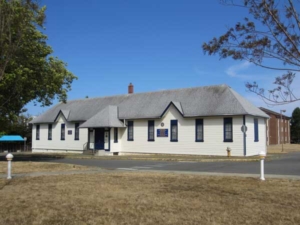
The former ‘Moro’ building at Work Point, now called the ‘Stettler’ building. Photo courtesy of Jack Bates.
Constructed in 1888, this building is one of three identical wood frame barracks made to Canadian design. It originally housed “C” Battery, Regiment of Canadian Artillery, and was officially occupied in 1891. Details of the buildings were published in the British Colonist on May 9, 1888. Ink on linen drawings of the building were auctioned off at Lunds auction house in Victoria in May 2012; the successful bidder is not known. WP 1004 is rated by the Federal Heritage Buildings Review Office (FHBRO) as “Recognized”, with a score of 51 points. It is currently in use by the CFB Esquimalt Fleet School. The building has been renovated to current building codes and the exterior of the building was painted in 2010.
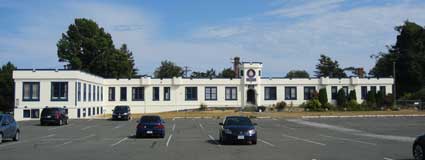
The “Haida” Building at Work Point – formerly the “Frezenburg'” Building. Photo courtesy of Jack Bates.
Built in 1898 to Canadian design for use as the base administration and headquarters, this wood frame building suffered a two-thirds loss of structure to the northerly portion due to a fire in 1917. It was rebuilt in 1918, adding the contemporary “turret” feature of the day over the main front entranceway. The southerly one-third was undamaged and still retains the original fireplace in the Commanding Officer’s area. The side wing was completed in September of 1938. WP 1020 housed the first HQ of the Canadian Women’s Army Corps (CWAC) in 1941, later under the command of Lt. Col. Joan Kennedy. It is FHBRO rated “Recognized” with a score of 55 points and is currently in use by the NOTC (Venture) and houses Company Quartermaster stores. The building has been maintained to current building codes and the exterior was repainted in 2010.
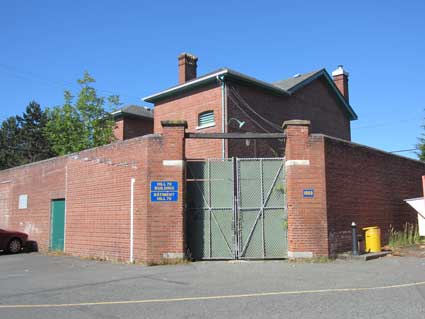
“Hill 70” building at Work Point was originally built as detention barracks. Photo courtesy of Jack Bates.
Built in 1904 of brick construction as the Detention Barracks for the Royal Garrison Artillery, it closed its detention doors and cells in 1958. It rates a FHBRO score of 48 points and is currently in use by CFB Esquimalt for Urban Search and Rescue Training.
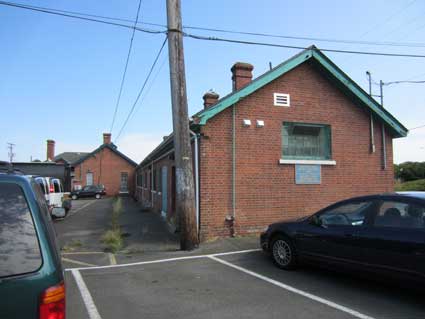
This 1902 brick building was constructed as offices and general stores for the Royal Garrison Artillery. Its former name was the “Arleux” building. Photo courtesy of Jack Bates.
Built in 1902 of brick construction as offices and general stores for the Royal Garrison Artillery (RGA), it forms a part of an identified historical precinct with the three other brick RGA-era buildings. It has the same FHBRO score of 48 points and is currently in use by the CFB Esquimalt as general stores and a seasonal training medical inspection room (MIR).
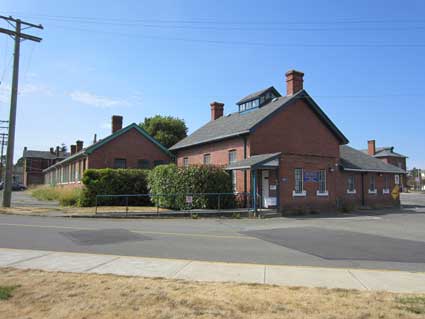
This buiding, formerly the Sergeant’s Mess for the Royal Garrison Artillery, was later consecrated as St. Barbara’s Chapel, in 1954. Photo courtesy of Jack Bates.
This brick building was constructed in 1902 and used as the Sergeant’s Mess for the Royal Garrison Artillery. Its most memorable presence was as St. Barbara’s Chapel, officially consecrated in 1954. It has a FHBRO score of 48 points and is currently in use by the Canadian Forces National Intelligence Unit.
Built in 1902 as two separate barracks buildings for the Royal Garrison Artillery, its centre adjoining portion was added in 1940. It is also commemorated as the “Ypres Building” or the “Cave Block” in reference to Col. J.C. Cave, the Commanding Officer of the day in 1957, who was responsible for renovating the building in preparation for the arrival of 1 PPCLI. It is FHBRO rated “Recognized” with a score of 66 points and is currently in use by the Nuclear Emergency Response Team of CFB Esquimalt.
A FHBRO score of 50 warrants the “Recognized” status, and 75 points warrants a “Classified” rating. These categories require an enhanced procedure for disposal and the FHBRO report 89-205 utilized for heritage purposes at Work Point was completed in 1989. This report, which gives a history of Work Point Barracks and the Victoria – Esquimalt Coastal Defence Fortifications System, includes individual building information and is available here – FHBRO report. *Please note that this is a large document and takes time to download. The FHBRO report is historically correct for the most part, with references dating to 1989. However, the scoring system remains outdated compared to heritage standards adopted by other jurisdictions. The custodial department (Department of National Defence) can request a heritage re-evaluation of buildings if it so desires.
WP 1001 (60 points), the original Work Point Barracks Guardhouse built in 1891, was sold in 2005; WP 1027 (56 points), the original 1890 Officer’s Mess and Quarters, was demolished in 2006. Both were FHBRO “Recognized” buildings of wood frame construction. WP 1001 – the former Guardhouse – is still a functional building, leased to the PPCLI Army Cadet Corps, and is an example of adaptive re-use.
WP 1030 (interim 42 points), the 1897 brick magazine overlooking Rose Bay, was demolished in 2014. It had no military designation but was part of the heritage commemoration site dedicated to the Canadian Artillery Regiments stationed at Work Point Barracks from 1888 to 1956.
The six surviving buildings in Work Point mentioned above have all served numerous military purposes for well over a hundred years, are acknowledged to be part of the Victoria–Esquimalt Coastal Defence System, and were included in heritage studies of 1974, 1982, 1989, 2001 and 2013. Currently they provide infrastructure for the unique and campus-styled NOTC (Venture) and form part of Canada’s National Defence residential, security and training programs.
Jack Bates of Victoria, B.C. has an abiding interest in researching, documenting and preserving the history of Esquimalt’s and Victoria’s military heritage.
To find out more about the history of Work Point, you can visit his website.
Articles
Hours
7 Days a Week: 10:00 am – 3:30 pm
Monday to Friday: 10:00 am – 3:30 pm
Hours
Monday to Friday: 8:00 am – 4:00 pm
To confirm if we are open, please call (250) 363-5655 or (250) 363-4312
Naval & Military Museum
Info@NavalAndMilitaryMuseum.org
CFB ESQUIMALT NAVAL & MILITARY MUSEUM
PO Box 17000 Stn Forces
Victoria, BC V9A 7N2